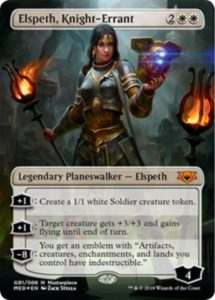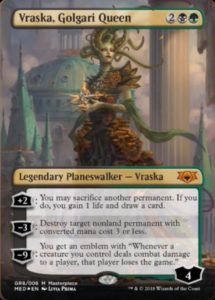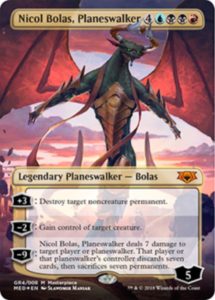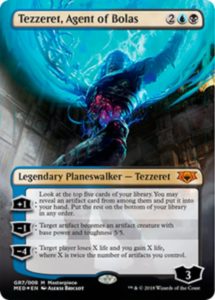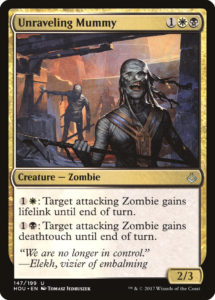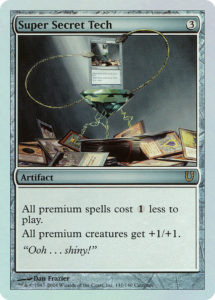One of my local game stores, the Geekery HQ, proposed running a Mythic Edition draft. This sort of thing is normally right up my alley—I love weird draft formats and I love having a Planeswalker in draft, so this checks enough boxes to be really cool. And then my brain turned to how such a draft would actually work. Well, everyone gets to first-pick a Planeswalker, and then the draft basically begins in earnest, where everyone has a strong preference based on who’s headlining their deck.
Today, let’s look at who’s in Mythic Edition and how they’ll work in draft. After all, Mythic Edition includes 24 boosters, just like Masters sets, and seems to be pushed for draft.
The Good
Elspeth, Knight-Errant makes perfect sense in Guilds of Ravnica. She’s outstanding with both Mentor and Convoke and is insanely powerful on her own. She’s an exciting and powerful card to play with. While she hasn’t been the second-best Planeswalker in a very long time, she didn’t have that reputation for nothing.
Liliana, the Last Hope is more generically powerful than Elspeth. She does play reasonably well with Undergrowth and the self-mill of Surveil, and should be powerful in a format with mostly small creatures. She and Elspeth are excellent picks in a multicolor format, as they slide into two pairs of guilds each and don’t require any support to be outstanding.
The Familiar
Ral, Izzet Visionary and Vraska, Golgari Queen are from Guilds of Ravnica. Obviously, they play well with their guilds and encourage players who first pick them to play their color combinations. They’re not quite as exciting or strong as Elspeth and Liliana, two of the more powerful Planeswalkers in history, but they’re nevertheless strong and are excellent first picks in draft.
The Interesting
There are three Planeswalkers who don’t fit into the GRN guilds but are nevertheless fine draft picks. Because all color pairs are represented within the shards and wedges, these three cards still have homes.
Teferi, Hero of Dominaria works well in a Jeskai deck, and that’s facile to draft since Boros and Izzet can easily splash for Teferi with one of those two guildgates. Daretti, Ingenious Iconoclast and Nicol Bolas, Planeswalker both work in Grixis, which Izzet and Dimir easily enable. Of these Planeswalkers, Bolas is probably my favorite inclusion—he’s taking over Ravnica, so he gets an extra moment in the spotlight here. And he’s obviously not guild-affiliated—just look at his colors!
Teferi is a sweet addition in that he’s Standard legal (and unlike Vraska and Ral, isn’t also in this set), one of the most valuable inclusions in Mythic Edition, and encourages offbeat deckbuilding. Jeskai control is a possible archetype, but not an obvious or common one in draft. Teferi doesn’t enable any shenanigans in particular, but he more than makes up for it by being one of the strongest Planeswalkers of all time.
Daretti is the strangest inclusion in this category. Sure, he enables himself, but he plays into an artifact theme that doesn’t exist in Guilds of Ravnica. There are only twelve artifacts in the set, and the only commons ones are the lockets (which you’re happy to turn into Putrefys with Daretti, but aren’t excited to draw when you don’t have him). Daretti’s ultimate isn’t likely to do much and reasonable sacrifice fodder for him won’t be easy to come by, so Daretti basically does two things: make chump blockers and throw them at enemies. But, while we’re on the subject of unsupported themes…
The Awful
What is Tezzeret, Agent of Bolas doing in this set? Daretti, Ingenious Iconoclast is in an unsupported guild and has an unsupported theme, but at least he functions by himself. Tezzeret has enormous deckbuilding constraints that render him nearly unplayable in draft. If you’re the person who opens Tezzeret at the table, you have two choices: abandon him completely, draft normally, and know that every opponent you face will have a powerful Planeswalker—or draft a whole bunch of lockets and pray that you find Tezzeret at the right time.
If all the Planeswalkers included in Mythic Edition forced different kinds of deckbuilding, then this would be a different conversation. Imagine lots of narrower Planeswalkers like Venser, the Sojourner, Nissa Revane, Jace, Cunning Castaway, and Liliana of the Dark Realms. The product wouldn’t have nearly as much value, but it’d be a weird, fun draft format. Or, if all eight Planeswalkers were supposed to be playable and a Dimir Planeswalker was essential, then why not include Ashiok, Nightmare Weaver? Ashiok is nuts, but then again, so are Elspeth, Liliana, and Teferi.
The Piece that Doesn’t Fit
Tezzeret is the thread that unravels Mythic Edition as a draftable product. He makes sense if the goal is to include a medium-priced Planeswalker that sees a small bit of Modern and Legacy play, but not if the goal was for him to also be playable in draft. I’m actually pretty surprised that neither Ajani, Mentor of Heroes, Nahiri, the Harbinger, nor Ajani Vengeant are in the set, since all of them are in the same price bracket but happen to actually be playable in GRN.
Unsurprisingly, the thought of opening a useless Tezzeret in a $75 event cooled my enthusiasm for drafting Mythic Edition. The product is one component away from congruence, and in something like an entire draft set, that’s an amazing success. The best Limited formats of all time had all sorts of issues (like how bad red was in Innistrad and Khans of Tarkir, green in MMA2013, or red again in Dominaria). However, Mythic edition is a product with only eight components, and 12.5% of the product is defective.
Premium Product
“But Zach,” you may well respond, “Mythic Edition obviously is a collector’s item first and foremost. Why are you evaluating it as a draft product?” An excellent question, and to which I’d respond, “Why are there booster packs? Why aren’t the Planeswalkers packaged as they are in From the Vault, Signature Spellbook, and Commander’s Arsenal—every comparable preceding product?” Because I’m concerned that the only reason the Planeswalkers are in booster packs is so that either customers, Hasbro, or Wizards of the Coast could countenance an MSRP of $250 by also including $50 worth of product (although a third of those boosters aren’t usable in normal draft). I don’t feel there’s anything morally wrong with Wizards of the Coast selling premium Planeswalkers that aren’t restricted to a particular product—some people love are collectors of foils or rare or expensive cards and this product gives them something special to be excited about. However, I have problems with dressing up something to look like what it isn’t.
Many of my friends have purchased Mythic Edition. However, the general reason for this was not that they wanted Mythic Edition in and of itself. Instead, they bought two copies so they could sell one for the cost of both, and then either keep the remaining copy or sell both at a tidy profit. Mythic Edition was funnily enough too inexpensive and vastly undershot its proper price point. From Wizards’ point of view, Mythic Edition was likely a resounding success, but I worry that it was successful only because it was so far below its proper price point that arbitrage kicked in.
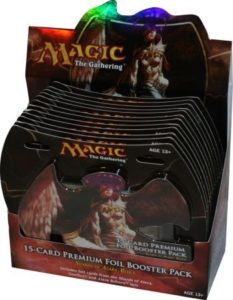 The Future of Funky Boosters
The Future of Funky Boosters
Wizards recently announced more premium, curated booster with Collector’s Boosters: packs with 2 foils, 3 rares/mythics, 10 uncommons, and 0 non-foil commons at an MSRP of $12.99. These probably are just meant for cracking, but they could make for an interesting, albeit bizarre draft environment. In fact, they remind me of one of my favorite booster products ever: All-Foil Alara packs. They were a commercial failure, but they were fun and weird to draft. Each booster contained 15 all-foil cards with the normal rare distribution and cards from all three sets of Alara block. It offered an experience unavailable anywhere else, though one where all the cards were designed to work together. I’m a bit concerned that Wizards seems to be returning to this model with Collector’s Edition and Mythic Edition, but those products are even less designed to be drafted with and seem more like cash grabs than products appealing to more than a tiny demographic. Yes, Collector’s Edition will be a very limited release, but so was Mythic Edition.
I appreciate that Magic has become more flexible and experimental in recent years. More experimentation in limited markets or with small print run products can enable underserved audiences or unknown customers to make their voices heard by buying or ignoring things. There are certainly markets for valuable, high cost Magic commodities and boosters designed to be cracked rather than played with. However, not only are these products not for me; but they’re of more restricted appeal, they’re suggestive of Magic embracing the damaging Whale model of freemium games, and they raise the specter of Magic one day going one step further with Buy-A-Box promos and printing new, powerful cards that are only available within such a restricted product. The sky isn’t falling because of Mythic Edition, Collector’s Edition, or Buy-A-Box promos, but I’m concerned of Magic dressing up a product like Mythic Edition as something it clearly wasn’t designed to be, and that they may continue to mislabel premium products in the future.
And, well, that’s all I’ve got to say about that. As always, thanks for reading.
—Zachary Barash
Zachary Barash is a New York City-based game designer and the commissioner of Team Draft League. He designs for Kingdom Death: Monster, has a Game Design MFA from the NYU Game Center, and does freelance game design. When the stars align, he streams Magic.
His favorite card of the month is Vedalken Entrancer. It’s a grindy, grindy card, combining reasonable but unexciting stats with a weak ability that can nevertheless win the game. It functions slowly enough to not take over the game, but its combination of defense and inevitability make for a solid card without being broken.

